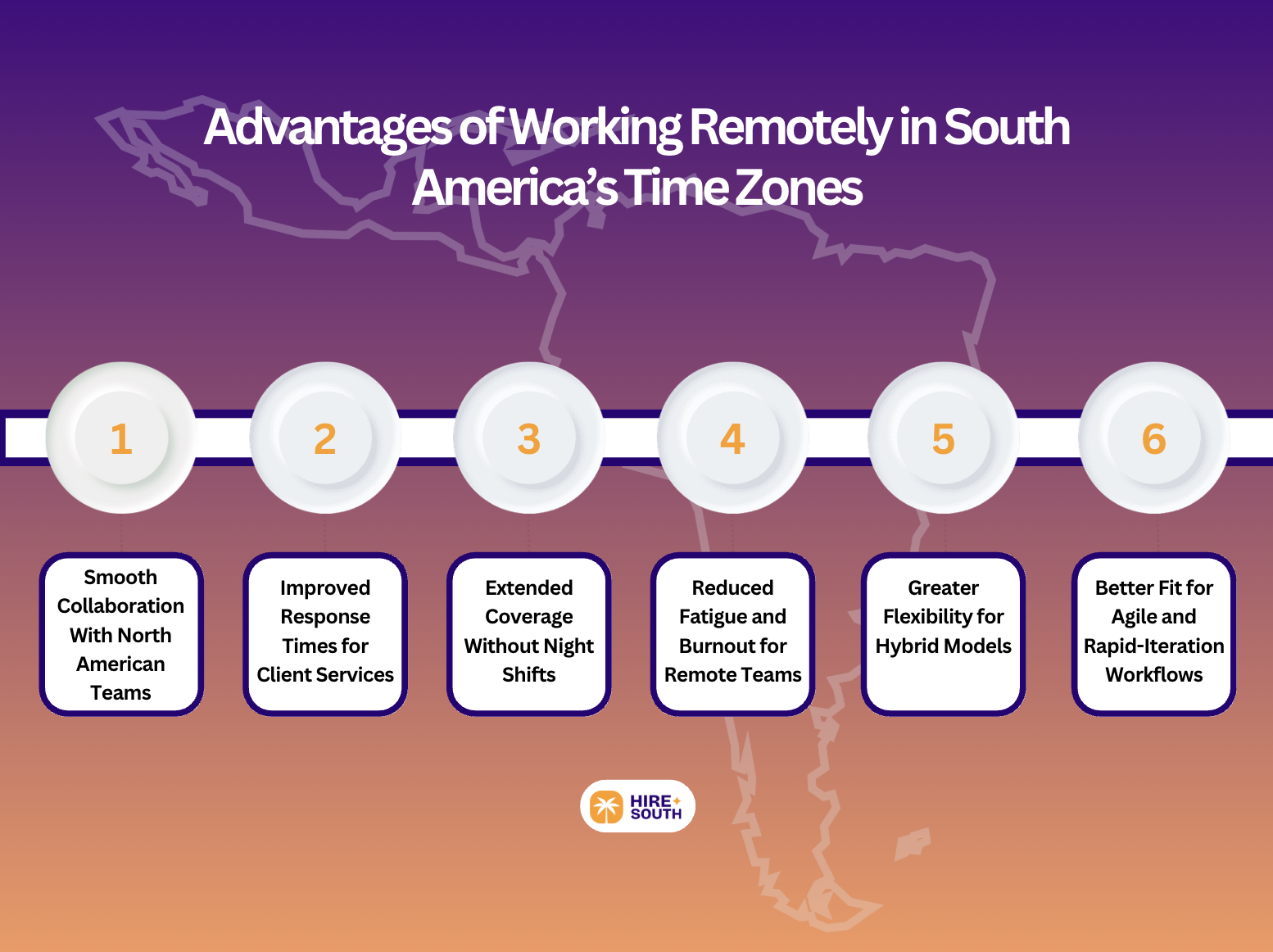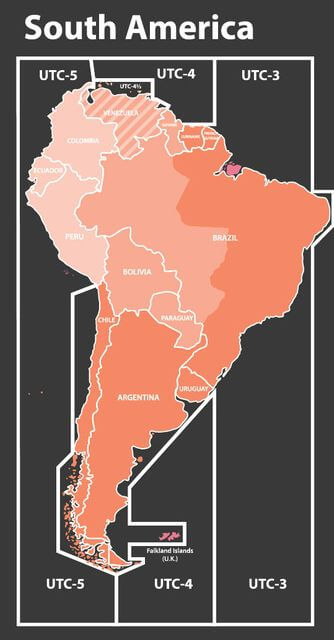Remote work thrives on clear communication and overlapping schedules. That’s why South America’s time zones are getting so much attention from global teams. Whether you’re in tech, marketing, customer support, or consulting, working in sync with clients and colleagues can make or break productivity.
From Argentina’s GMT-3 to Colombia’s GMT-5, South America offers time zone options that align closely with North American working hours. This overlap means fewer late-night calls, faster feedback loops, and smoother project management. According to Owl Labs, 62% of remote workers say time zone compatibility is critical to their efficiency, and South America checks that box.
This article maps out the region’s time zones, compares their advantages for remote work, and helps you choose the one that best fits your business model. You’ll see where collaboration is easiest, which zones offer the most overlap with your target markets, and how to navigate potential challenges. By the end, you’ll know why South America’s time zones are more than just convenient; they’re a competitive advantage.
Why South America Remains a Strategic Remote Work Location
1. Time Zone Overlap With Major Markets.
South America’s time zones line up closely with North American business hours. For example, Buenos Aires (GMT-3) and São Paulo (GMT-3) are only one or two hours ahead of New York for most of the year. This allows real-time collaboration without forcing teams to work outside standard hours.
2. Access to Skilled Talent Pools.
The region’s workforce is growing in both technical and creative sectors. The Inter-American Development Bank reports that Latin America produces over 500,000 STEM graduates annually, with countries like Brazil, Argentina, and Colombia leading in software development, digital marketing, and business operations. This steady talent supply supports long-term scalability for remote teams.
3. Stable Internet and Infrastructure in Key Cities.
Cities like Santiago, Montevideo, and Medellín have invested heavily in broadband coverage, often exceeding 200 Mbps in urban business hubs. According to Speedtest Global Index, Chile ranks among the top 10 countries in fixed broadband speeds worldwide, giving remote teams reliable connectivity for video calls, cloud collaboration, and data-intensive work.
4. Cultural Alignment With Western Clients.
South American professionals often share similar workweek structures, business etiquette, and communication styles with North American and European counterparts. This cultural compatibility reduces onboarding time, helps maintain client relationships, and simplifies cross-border collaboration.
5. Cost Efficiency Without Sacrificing Quality.
While labor costs vary by country, many South American professionals offer competitive rates compared to U.S. and European counterparts, without compromising expertise or experience. This allows companies to allocate budgets more strategically, investing in growth rather than just operational overhead.
6. Growing Nearshore Outsourcing Ecosystem.
Nearshore outsourcing to South America has expanded rapidly, with global IT services spending in the region projected to reach $27.5 billion by 2026, according to IDC. Governments are also encouraging foreign investment through tax incentives, startup programs, and infrastructure grants, making it easier for businesses to establish or expand remote operations.
Advantages of Working Remotely in South America’s Time Zones

Smooth Collaboration With North American Teams.
Many South American countries share overlapping work hours with the United States and Canada. For instance, Colombia (GMT-5) mirrors Eastern Standard Time for much of the year, allowing meetings and deadlines to be managed in real time. This overlap reduces project delays and makes coordination far more efficient than working across a five- to eight-hour gap.
Improved Response Times for Client Services.
If your clients are based in North America, having a team in a similar time zone means faster replies and issue resolution. According to Harvard Business Review, response time is one of the top three drivers of customer satisfaction in B2B relationships, making time zone alignment a direct competitive advantage.
Extended Coverage Without Night Shifts.
For companies working with multiple markets, placing part of the workforce in South America enables near 24-hour operations without resorting to late-night shifts. For example, a U.S. West Coast team and a Chilean team can cover a wider operational window while still working regular business hours locally.
Reduced Fatigue and Burnout for Remote Teams.
When teams share similar working hours, employees avoid the physical strain of early morning or late-night calls. The American Academy of Sleep Medicine notes that irregular work schedules can lead to a 40% higher risk of burnout, so aligning time zones supports healthier, more sustainable productivity.
Greater Flexibility for Hybrid Models.
South America’s time zones make it easier to mix remote and in-person collaboration. A business can maintain a headquarters in the U.S. while holding regular real-time planning sessions with South American team members, eliminating the need for awkwardly timed virtual meetings.
Better Fit for Agile and Rapid-Iteration Workflows.
Agile methods rely on quick feedback loops and regular stand-ups. A short time difference keeps sprint reviews, backlog grooming, and daily stand-ups on schedule without forcing team members to adjust their natural working rhythms.
The Best Remote Work Time Zones in South America

1. GMT-3: Argentina, Uruguay, and Parts of Brazil
GMT-3 is one of the most convenient time zones for remote teams working with North America’s East Coast. The difference is typically just one or two hours, which keeps meeting times natural for both sides. Buenos Aires, Montevideo, and São Paulo are all in this zone, offering large, skilled workforces. The overlap also makes it easier to coordinate with European teams in the early hours.
2. GMT-4: Chile, Bolivia, and Western Brazil
This time zone strikes a balance between North American and European markets. Santiago and La Paz operate just one hour behind Argentina, maintaining a strong connection to Eastern Standard Time while giving teams a slightly earlier alignment with Europe.
3. GMT-5: Colombia, Peru, and Ecuador
GMT-5 matches Eastern Standard Time for most of the year, making it ideal for U.S.-based businesses that require full-day real-time interaction. Bogotá, Lima, and Quito all have growing tech and service sectors, with Colombia ranking among the top three Latin American countries for IT service exports according to ProColombia. This zone works especially well for client-facing roles where response speed matters.
4. GMT-2: Atlantic Islands of Brazil
Though less populated, this time zone offers a unique advantage for global companies targeting Europe. The difference from London is just three hours, making it possible to manage European accounts during normal working hours while still maintaining some overlap with North America. It’s more niche, but valuable for specific operational needs.
5. GMT-3 and GMT-5 Combined Strategy
Some companies blend teams across GMT-3 and GMT-5 to extend coverage without sacrificing real-time collaboration. This setup gives nearly full-day overlap with both U.S. coasts while keeping shifts within normal business hours. For distributed teams, this approach supports agile workflows without the fatigue caused by large time gaps.
Visualizing South America’s Time Zones
South America spans four main standard time zones, from GMT-2 to GMT-5. Most countries do not observe daylight saving time, which keeps scheduling predictable year-round. This stability is a major advantage for remote teams, especially compared to markets where clocks shift twice a year.
Key Cities in Each Time Zone:
- GMT-2: Fernando de Noronha (Brazil)
- GMT-3: Buenos Aires, Montevideo, São Paulo, Brasília
- GMT-4: Santiago, La Paz, Manaus
- GMT-5: Bogotá, Lima, Quito
These cities represent the largest business and tech hubs in their respective zones, offering talent pools, infrastructure, and connectivity essential for remote work.
Regional Differences Between East and West Coasts:
The eastern countries, including Brazil, Uruguay, and Argentina, generally run GMT-3, aligning well with North American morning schedules. Western countries like Colombia, Peru, and Ecuador operate on GMT-5, creating full-day overlap with Eastern Standard Time. This east-west variation gives businesses flexibility to choose a zone that best matches client and operational needs.
Tools to Check Current Time Zones in South America:
To avoid scheduling mistakes, tools like TimeandDate.com, World Time Buddy, and Google’s built-in time search provide instant conversions for any South American city. These are especially useful when coordinating across multiple zones or with international partners.
Ready to Hire LATAM Talent and Leverage South American Time Zones?
South America’s time zones offer a rare mix of global connectivity and operational efficiency. With up to 8 hours of overlap with major North American markets and minimal seasonal time zone changes, the region enables companies to maintain real-time collaboration without disrupting their work-life balance. The Inter-American Development Bank notes that LATAM’s professional talent pool is growing by over 3 million skilled workers annually, a clear sign that the infrastructure and expertise to support remote teams are already in place.
At Hire South, we help businesses tap into this advantage by connecting them with vetted professionals across South America’s most strategic time zones. Our experience in nearshore hiring ensures you not only find the right talent but also align your operations with the time zone that best supports your market goals. This approach minimizes delays, optimizes communication, and strengthens your team’s ability to deliver on time, every time. Ready to find your next talent? Contact us to make it happen!

Ready to Hire LATAM Talent?
Let us do the legwork to find your perfect remote hire in Latin America!



.jpg)



.svg)